Chlorophyll is a molecule found in plants that gives them their
green color and plays a big part in photosynthesis. It can also be
fun to extract from plants and do some fluorescence experiments with
since in ultraviolet light it shows up as red.
Chlorophyll from spinach.
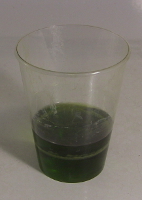 |
|
Fluorescing red in concentrated sunlight.
 |
|
Fluorescing red laser beam.
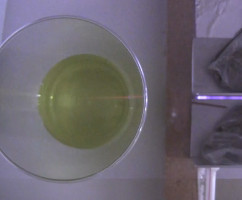 |
|
Extracting chlorophyll from spinach
Here's how to extract chlorophyll from spinach though the same technique
should work with many other green leafs and even green grass. The fresher
the plant the better.
Chop up some fresh spinach.
Put it in a container. I'm using a
plastic cup.
Step 1. Get spinach...
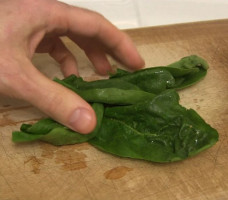 |
|
... and chop it.
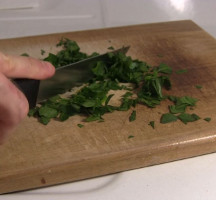 |
|
Step 2. Put in container.
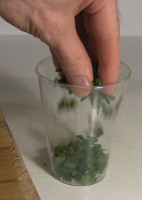 |
|
Pour in some rubbing alcohol.
You can get rubbing alcohol in drug stores/pharmacies or the sections
of grocery stores that carry medicinal items.
Put a coffee filter in a second
container and transfer the contents from the first cup into
it. Do a little at a time if the coffee filter is too small for all of it.
Step 3. Pour rubbing alcohol.
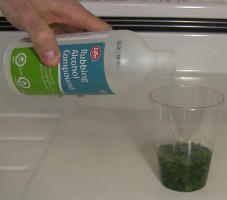 |
|
Step 4. Put coffee filter...
 |
|
... and contents.
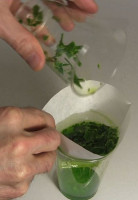 |
|
Gradually the rubbing alcohol
will carry some chlorophyll into the second cup, leaving that cup
with a green liquid.
When there's practically no
more liquid in the coffee filter you're done.
Step 5. Filtering.
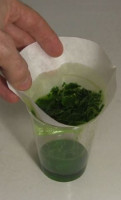 |
|
Step 6. Done.
 |
|
Testing the chlorophyll using fluorescence via sunlight
When you shine ultraviolet light on chlorophyll it gives off
red light by a process called fluorescence. And the easiest place to
get ultraviolet light is the sun. So here's perhaps the easiest way
to test if you succeeded in getting chlorophyll, plus it makes a
neat science project demonstration.
Below I've simply sat the container of chlorophyll in direct sunlight.
I put it on a dark background, otherwise there would be a lot of
glare from the reflected sunlight and I wouldn't be able to see
the color of the chlorophyll clearly. But you can see that it
appear reddish.
Putting chlorophyll in direct sunlight.
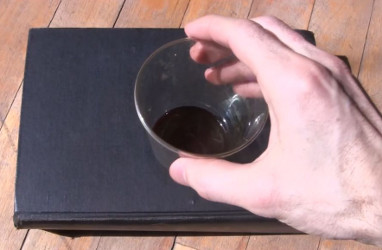 |
|
Chlorophyll fluorescing red in sunlight.
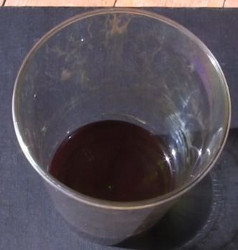 |
|
To get an even stronger effect, I use a magnifying glass to concentrate
the sunlight, which includes both the visible light and ultraviolet
light. You can clearly see the the chlorophyll is giving off red light.
Chlorophyll fluorescing strongly red in concentrated sunlight.
 |
|
Using a homemade TEA laser to make chlorophyll fluoresce
My homemade TEA laser puts out ultraviolet
light, which you can't see with the naked eye. But if you shine it
through a container of chlorophyll then it makes the chlorophyll
fluoresce red, making the laser beam visible since we can see red light.
But first I had to make get a mix of chlorophyll that wasn't so
dense, otherwise the laser beam wouldn't get very far through the
liquid. So I poured some alcohol into another container and added some
of the chlorophyll which I previously made.
Pouring alcohol and...
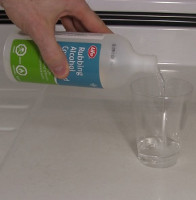 |
|
... chlorophyl.
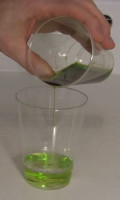 |
|
The dilute one is on the left.
 |
|
The TEA laser firing without the mixture.
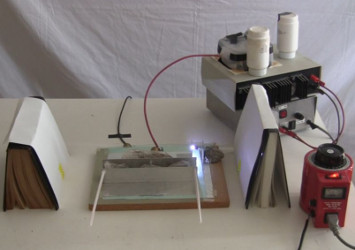 |
|
The red fluorescing beam in chlorophyll.
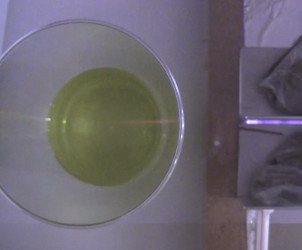 |
|
Video - How Fluorescence works using TEA Lasers and the Electromagnetic Spectrum
In this video I explain fluorescence and then do some demonstrations.
The last demonstration is the one where I show how to extract chlorophyll
from spinach and then make it fluoresce using concentrated sunlight and
my TEA laser.



















